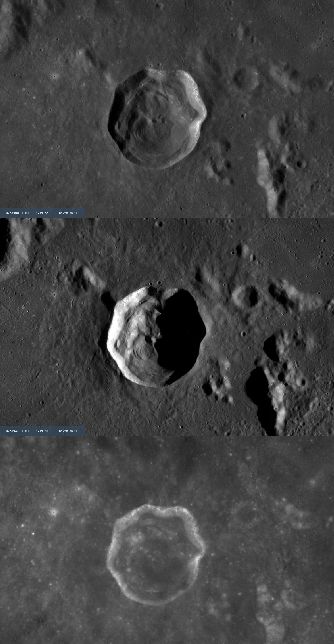Mösting
Contents
Mösting
|
Lat: 0.7°S, Long: 5.9°W, Diam: 24 km, Depth: 2.8 km, Rükl 43, Copernican |


Left: LOIV-109H1, Right: LOIV 108 H3, Mösting (top) and Mösting A (bottom)

LRO in three different iluminations!
Images
LPOD Photo Gallery Lunar Orbiter Images Apollo Images
- - Lunar Orbiter 3's Frame 107 is an interesting close-up of Mosting's chaotic floor and inner slopes.
- - Although the name Mosting is not mentioned in the LPI's search-list of orbital Apollo photographs, it (the crater called Mosting) was photographed by Apollo 16's mapping/metric Fairchild camera. The last eight frames of north-looking REV 27 (Revolution 27) show Mosting near the curved horizon, as seen after local sunrise.
- - Mosting is also noticeable on Apollo 16's north-looking REV 37 (Revolution 37), from frame 1407 to frame 1416. Of these, frame 1411 shows Mosting near the central part of the curved horizon.
- - Mosting A, the well known high albedo crater south-southeast of Mosting itself (on the western part of Flammarion's rim) is also noticeable on both Apollo 16's REV 27 and REV 37. On the zoomify-scans of the Apollo Image Archive (Arizona State University) it's even possible to explore the reflected light on the shadowed eastern inner slopes of it (of Mosting A).
- - Research Lunar Orbiter 3 and Apollo 16 photography: Danny Caes.
Maps
(LAC zone 77A1) LAC map Geologic map LM map AIC map
Description
Description: Elger
(IAU Directions) MOSTING.--A very deep ring-plain, 15 miles in diameter, near the moon's equator, and about 6 deg. W. of the first meridian. There is a crater on the N. side of its otherwise unbroken bright border, an inconspicuous central mountain, and, according to Neison, a dark spot on the S. side of the floor. At some distance on the S.S.E., stands the bright crater, Mosting A, one of the most brilliant objects on the moon's visible surface.
Description: Wikipedia
Additional Information
- Depth data from Kurt Fisher database
- Pike, 1976: 2.8 km
- Arthur, 1974: 2.76 km
- Westfall, 2000: 2.8 km
- Viscardy, 1985: 2.76 km
- Cherrington, 1969: 2.98 km
- Differences in lunar control systems are often (partially) specified, by stating the coordinates (longitude and latitude) of the bright satellite crater Mösting A (mentioned by Elger) in that system. The basic idea is that if one tracks its offset from the Moon's visual center long enough the average result will be its latitude and longitude at zero libration, although complicated mathematical theories of the Moon's librations at the time of the observations are used in the actual data reduction. According to Wollenhaupt et al. the best Earth-based result for the position of Mösting A at zero libration was 3.18°S / 5.16°W, a value that was thought to be accurate to better than 0.002° or 0.05 km on the Moon. However, when its location was independently checked based on sextant readings from the radar-tracked Apollo 14 Command Modules the result was a Mean-Earth centered position of (3.35 +/- 0.02)°S / (4.96 +/- 0.01)°W. The discrepancy of 0.27 degrees, or about 8 km on the Moon’s surface, was thought to reflect systematic errors in the Earth-based telescopic results, but later producers of lunar control networks do not seem to have fully embraced the Apollo result. The value in the 1994 ULCN is 3.212°S / 5.211 W°1737.527; and in ULCN 2005 it is 3.2181°S/ 5.2508°W. There are similar discrepancies in the estimated radial distance of the rim of Mösting A from the Moon's center. - JimMosher
- Mosting and its satellite crater A are on the ALPO list of bright ray craters
- Satellite crater Mosting A is on the ALPO list of banded craters
- Mosting and Mosting A & C are thermal anomaly craters, implying youthful ages - Moore et al, 1980
- Mutch, 1970 (pp. 63-66, and Figures IV-3-4) offers 3.5-km diameter Mosting C (1.8°S / 8.0°W) as the archetype of a class of fresh craters with "circular plan views, simple cup-like profiles, sharply raised rims, and prominent surrounding ejecta, frequently with a hummocky inner facies and a radial outer facies," which from Earth gives the appearance of "a perfect cup-shaped depression with a bright halo." He notes that when examined in detail from lunar orbitit it is actually seen to have a somewhat flat floor and other complex details, both inside and outside the rim. The flat floor is especially evident in the Clementine mosaics. Mutch gives the depth of Mosting C as 330 m, and says the walls slope inward at 10°. - JimMosher
- TSI = 20, CPI = 20, FI = 15; MI =55 Smith and Hartnell, 1973
- The degraded crater Mosting E (east-northeast of Mosting itself) was known as Sommering M on chart 55 in the Times Atlas of the Moon. Northward of this degraded crater (Mosting E or Sommering M) is the location of a possible swirl field. - DannyCaes Jan 31, 2016
Ancient crater southwest of Mosting?
- SLC map D5 shows the location of an unnamed large crater southwest of Mosting. The diameter of this ancient crater seems to be more-or-less the same as Alphonsus.
Nomenclature
- Named for Johan Sigismund von Mösting, a Danish benefactor (1759-1843).
- Quoting Who's Who on the Moon, In 1821 he asked Schumacher to edit a journal in which astronomers might exchange news and views, and secured State assistance for this publication, the Astronomische Nachrichten.- tychocrater Aug 9, 2007
LPOD Articles
Lunar 100
L61: Mösting A - Simple crater close to center of lunar near side.
Bibliography
- Gondolatsch, F. 1942. Johann Sigismund von Mösting und der Mondkrater Mösting A. Die Sterne 22, 17.